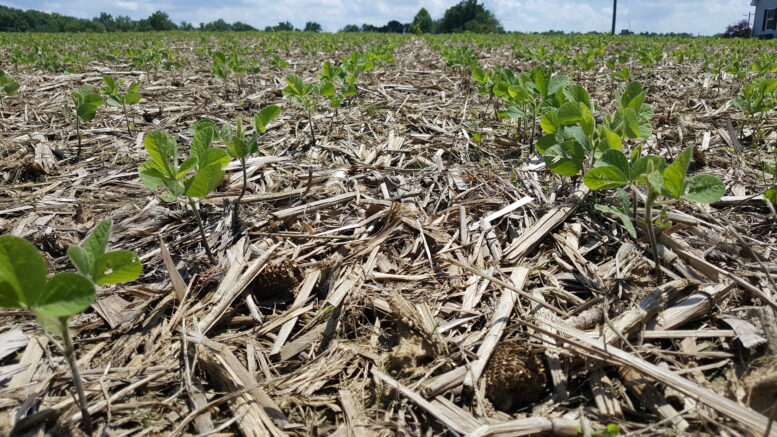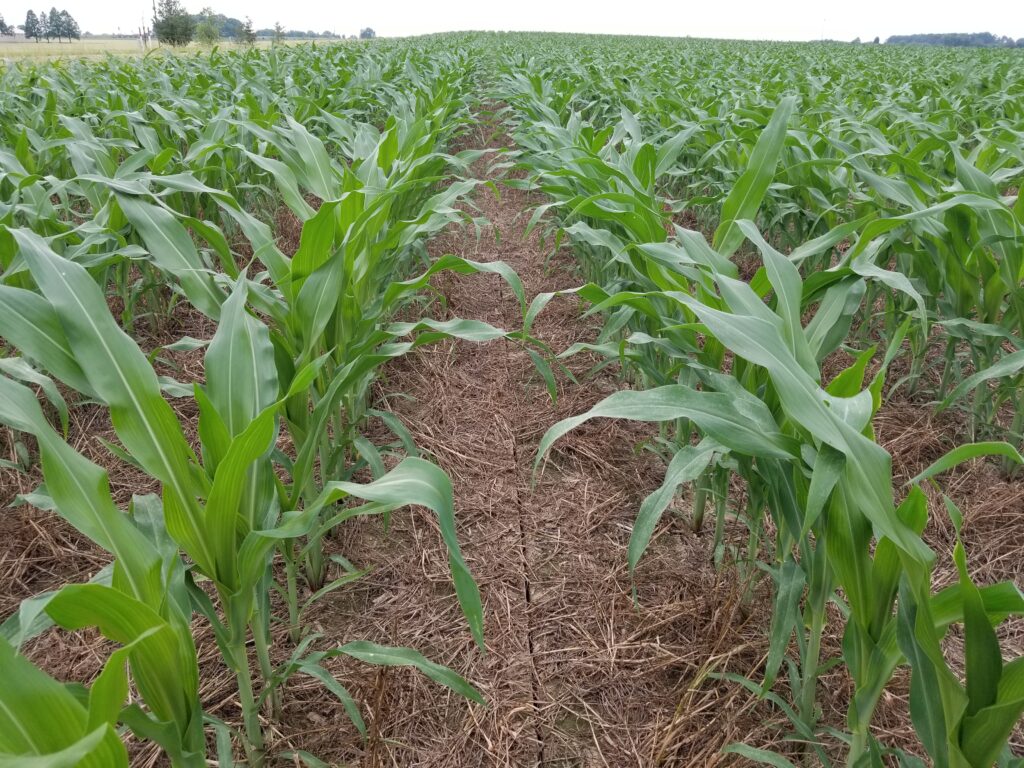By Nick Werner, for the Delaware County Soil & Water Conservation District—
DELAWARE COUNTY, IN—Jeremy Russell visited the Dave Brandt Farm in Carroll, Ohio, in 2014, and on the three-hour drive home to Delaware County, Indiana, his mind was churning with ideas.
Brandt is a well-known pioneer in the area of regenerative farming, and Russell wanted to apply what he had learned to his own corn, soybean and wheat operation.
“That trip was an eye-opening experience,” Russell said. “Brandt has been using cover crops and no-till since the 1970s. His soils compared to his neighbors was night-and-day.”
Russell, who is currently in his ninth year of farming, imagined what his soils could look like by the time he was in his 50s.
He envisioned a future wherein he worked more in harmony with nature. A future wherein his increasingly fertile land required less investment in fertilizer and herbicide, boosting his profit margins, even in down years. He envisioned a farm that was stable and self-sufficient, insulated against wild fluctuations in weather and markets.
And he got to work.
Russell was already farming no-till, but he quickly developed a plan for cover crops too – perhaps the most important pillar in regenerative farming.
“Regenerative farming is a long slow grind that picks up speed,” Russell said. “But it’s a fun thing to do because it happens to be one of those things where the right thing to do environmentally is also the right thing to do economically. You are being a good steward and that makes it rewarding.”
An educational opportunity, Aug. 25
Regenerative farming has no standard definition. Russell describes it as farming in a way that leaves your soils better than you found them. The regenerative movement evolved from the sustainable movement that began a couple decades ago. The notion of sustainability, while admirable, did not set the bar high enough for many conservation-minded farmers.
“Our soils now compared to what they were when we first broke ground in the Midwest more than a hundred years ago are a significantly degraded resource,” he explained. “There was this sense that sustainability wasn’t enough. We need to make things better.”
Russell isn’t just a regenerative farmer, like Dave Brandt he’s a regenerative evangelist, too.
As part of an educational day through the Delaware County and Blackford County Soil and Water Conservation Districts, Russell is inviting people to come to his farm to see regenerative strategies in action.
The Regenerative Agriculture Journey: Stories from East Central Indiana and Beyond, is Aug. 25, with most events taking place at the Delaware County Farm Bureau, 6100 IN-67 N, Muncie, IN 47303. It runs from 8 a.m. to 2 p.m.
Attendees will hear from four Hoosier farmers, including Russell, about the benefits of regenerative agriculture.
“There are a lot of us across the cornbelt who are experimenting,” he said. “Everyone is very encouraging. We are all working toward a common goal and it’s nice to interact with people who want to see you succeed.”
Strategies
Another one of those experimenting farmers is Joe Hamilton, a former mechanical engineer, who also grows corn and soybeans in Delaware County. Hamilton will also speak at the education day on Aug. 25.
“Engineers make good farmers,” he said. “They pay attention to details. They like to change variables and see results. I feel like I run the farm as a continuous experiment, trying to make things better and optimize outcomes.”
In 2017, Hamilton converted to continuous no-till for all 2,500 of acres he farmed. That same year, he also planted about 100 acres of cereal rye after a corn harvest and before planting soybeans the next year.
The benefits of regenerative farming, according to Hamilton and Russell, are pretty simple:
— Less weed pressure on cash crops.
— Improved water infiltration for cash crops.
—Breaking up compaction and improved soil structure.
—More organic matter in the soil.
After planting cover crops, Hamilton began to notice that compacted layers of soil were beginning to break up. So, in 2019, with help from the NRCS EQIP federal cost-share program, he enrolled half his acres into cover crops. Currently, about 90 percent of his acres are in cover crops.
Those cover crops are, primarily, annual ryegrass, spring oats, rapeseed, and crimson clover.
“The funding varies by state and by region on how much they will give you,” he said. “It’s anywhere from 50 to 100 percent.”
Hamilton has had to modify some of his equipment, but as a former engineer, he loves that part of farming.
Hamilton has also mixed a livestock and grazing strategy into his cover crops, albeit on a small scale for now. On 24 acres, he plants corn rows on 60 inches, as opposed to 30, and grows a mix of grazing crops in between. After harvest, he lets about nine head of cattle into the field, and the manure plus the grazing improves the soil.
He’s uncertain whether he will scale up this strategy.
“I’m just doing it for some freezer beef for myself and friends and family right now,” he said.
Just try it
How you measure success in regenerative farming varies by farmer and by what their unique objectives are.
Russell, though, has a very specific goal. He wants his soils to have about 5.5 percent organic matter in them. Why 5.5 percent? Because in 2012, he bought some acreage that had always been either woods or pasture. It had never been broken for row crops. When they tested the soils there, they were composed of about 5.5 percent organic matter.
“Organic matter is your leading indicator of soil health,” he said. “This was undisturbed soil in close to its natural state. So that gave us a baseline for the rest of our operation.”
His soils currently range in the 2.5-4 percent range, and Russell knows the work will take years. Still, he has already seen enough progress to recommend regenerative farming to others.
His advice?
Check out the Aug. 25 Education Day, and then give it a shot. Don’t be afraid to fail. Trial and error is part of regenerative farming.
“Just try it,” he said. “Get your feet wet and let your experiences guide you. Sometimes things don’t work out or mother nature throws a wrench at you. It’s not going to be perfect, but you are trying something new and learning from it.”




